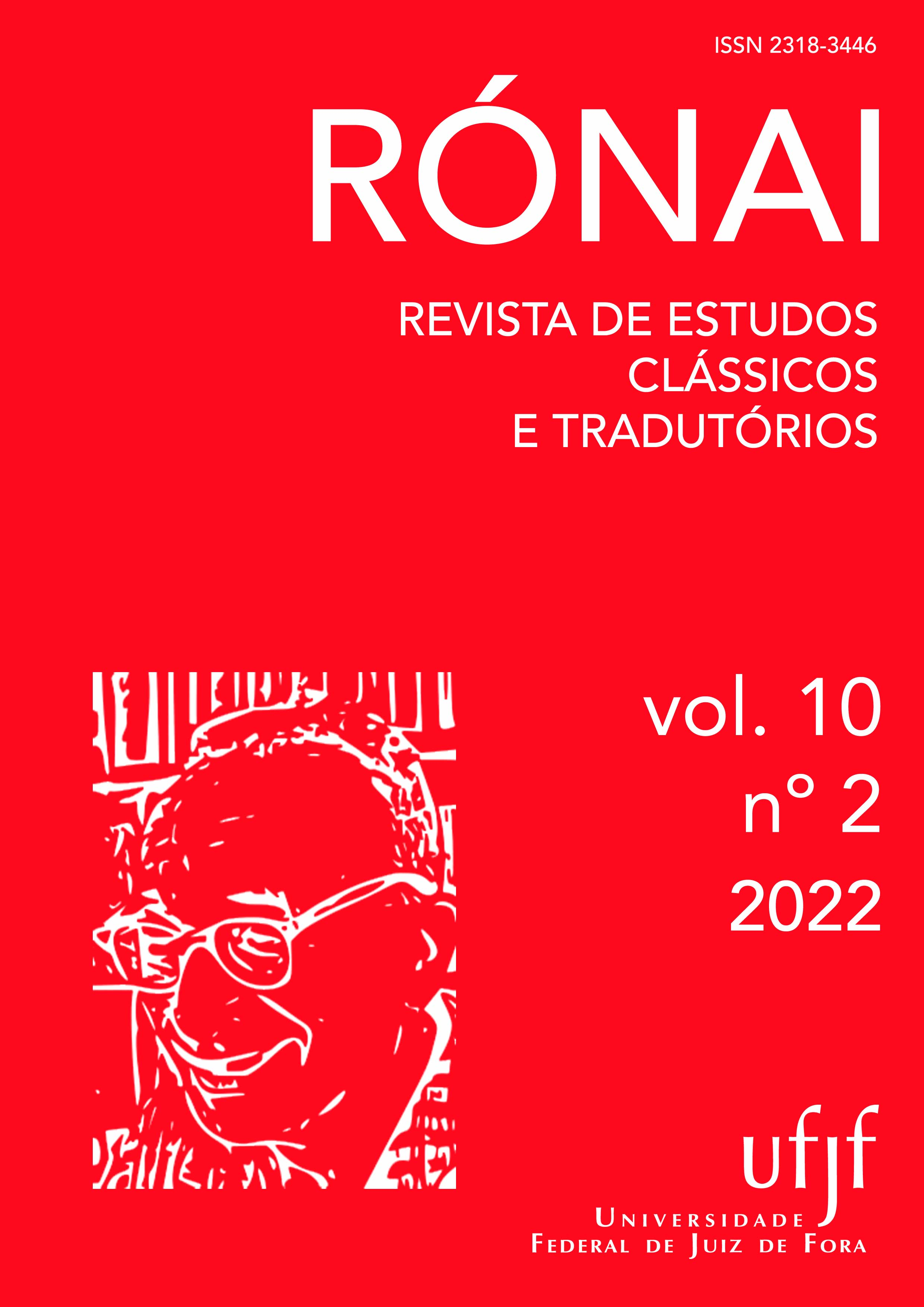Elsa Morante’s Menzogna e sortilegio translation issues
DOI:
https://doi.org/10.34019/2318-3446.2022.v10.38045Keywords:
Italian literature, Elsa Morante, translationAbstract
This article raises issues about the translation process of the Italian writer Elsa Morante’s novel Menzogna e sortilegio as an exercise to bring together cultural, historical, social and economic relations, in addition to addressing gender issues, especially the role of women and social reproduction. In the dialogue between the domesticating, foreignizing and exoticizing practices of translation examined by Lawrence Venuti, the Henri Meschonnic’s alterity studies and Umberto Eco’s reversibility concept, I analyzed possibilities of how to translate into Portuguese what was written in Italian, adopting a feminist translate practice. From this analysis arise Some questions and possibilities of organizing the writer's own lexicon, with recurrent terms and images in her works.
Downloads
References
AZEVEDO, Francisco Ferreira. Dicionário analógico da língua portuguesa: ideias afins/thesaurus. 3 ed. 3º reimpressão. Rio de Janeiro: Lexicon, 2020.
BOHÁCKOVÁ, Michaela. Le prime opere di Elsa Morante: tra sogno e racconto. Magisterská Diplomová Práce. Filozofická fakulta. Masarykova Univerzita, Brno, 2017.
CABRAL, Luciana. Literatura e maternidade em Elsa Morante. Rio de Janeiro: Multifoco, 2017.
CALVINO, Italo. Un romanzo sul serio. L’Unità, 1948. Disponível em: http://193.206.215.10/morante/periodici/mes_giornali/UNITA_TO00001.html. Acesso em 24 nov. 2022.
CAUSIN, Susanna. Riscrivere e reinventare l’identità femminile nella narrativa italiana del XX e XXI secolo – Elsa Morante e Elena Ferrante. Tesi di laurea in Filologia e Letteratura Italiana. Università Ca’Foscari, Venezia, 2018.
CHESTERMAN, Andrew. Ethics of translation. In: SNELL-HORNBY, M.; JETTMAROVÁ, Z.; KAINDL, K. (eds.). Translation as Intercultural Communication. Amsterdam/Philadelphia: John Benjamins, 1997. p. 147-157.
COSTA, Claudia de Lima; ALVAREZ, Sonia E. A circulação das teorias feministas e os desafios da tradução. Revista Estudos Feministas, v. 21, n. 2, 2013, p. 579-586.
DALLA COSTA, Maria. Donne e sovversione sociale – Un metodo per il futuro. Verona: Ombre corte, 2021.
DE ROGATIS, Tiziana. Realismo stregato e genealogia femminile in "Menzogna e sortilegio” di Elsa Morante. Allegoria, v. 80, 2019, p. 1-31.
DIZIONARIO GARZANTI DI ITALIANO. Milano: Garzanti, 1999.
EAGLETON, Terry. Teoria da literatura. Uma introdução. Tradução de Waltensir Dutra. São Paulo: Martins Fontes, 2019.
ECO, Umberto. Quase a mesma coisa. Rio de Janeiro: Record, 2007.
FERRANTE, Elena. La frantumaglia. Roma: Edizioni e/o, 2014.
GARBOLI, Cesare. Il gioco segreto: nove immagini di Elsa Morante. Milano: Adelphi Edizioni, 1995.
GARBOLI, Cesare. Introduzione. In MORANTE, E. Menzogna e sortilegio. Torino: Einaudi, 1994.
GONZALEZ, Lélia. Por um feminismo afro-latino-americano. Rio de Janeiro: Zahar, 2020.
HOUAISS, Antônio; VILLAR, Mauro de Salles; FRANCO, Francisco Manoel de Mello (diretores). Pequeno dicionário Houaiss de Lexicografia. Instituto Antônio Houaiss de Lexicografia. São Paulo: Moderna, 2015.
LUKÁCS, Georg. A teoria do romance: um ensaio histórico-filosófico sobre as formas da grande épica. Tradução, posfácio e notas de José Marcos Mariani de Macedo. São Paulo: Duas Cidades; Editora 34, 2009.
MESCHONNIC, Henri. Poética do traduzir. São Paulo: Perspectiva, 2010.
MORANTE, Elsa. A ilha de Arturo. Tradução de Roberta Barni. São Paulo: Carambaia, 2019.
MORANTE, Elsa. L’isola di Arturo. Torino: Einaudi, 2011.
MORANTE, Elsa. Menzogna e sortilegio. Torino: Einaudi, 2010.
MORANTE, Elsa. A ilha de Arturo. Tradução de Loredana de Stauber Caprara. São Paulo: Berlendis & Vertecchia Editores, 2003.
NASCIMENTO, Abdias. O quilombismo. Documentos de uma militância Pan-Africanista. São Paulo; Rio de Janeiro: Editora Perspectiva; Ipeafro, 2019.
NASCIMENTO, Beatriz. Uma história feita por mãos negras: Relações sociais, quilombos e movimentos. Rio de Janeiro: Zahar, 2021.
PEDULLÀ, Walter. La narrativa italiana contemporanea (1940-1990). Roma: Newton Compton editori, 1995.
PYM, Anthony. Pour une éthique du traducteur. Ottawa: Presses de l’Université, 1997.
RIPANTI, Espérance Hakuzwimana. E poi basta. Manifesto di una donna nera italiana. Gallarate: People, 2019.
SCEGO, Igiaba. Minha casa é onde estou. Tradução de Francesca Cricelli. São Paulo: Editora Nós, 2018.
SCHWARCZ, Lilia Moritz. Nem preto nem branco, muito pelo contrário. Cor e raça na sociabilidade brasileira. São Paulo: Claro Enigma, 2012.
VENUTI, Lawrence. A invisibilidade do tradutor. Uma história da tradução. São Paulo: Editora Unesp, 2021.
WOLF, Michaela; SERPA, Talita. Tradução “tornando-se social”? Desafios para a torre (de marfim) da Babel. Cadernos de Tradução, Florianópolis, v. 41, n. 1, p. 344-367, jan-abr, 2021.
Downloads
Published
How to Cite
Issue
Section
License
Copyright (c) 2022 Luciana Cabral Doneda

This work is licensed under a Creative Commons Attribution 4.0 International License.
Copyright
The authors of the published contributions agree with the following items:
1. The authors keep the copyright and convey to the journal the right of first publication, the work being licensed under a Creative Commons Attribution License 4.0 International.
2. The authors are allowed and stimulated to publicize and distribute their work online after the publication in the journal, recognizing first publication in this journal.
3. The authors of the approved works authorize the journal to distribute their content, after publication, for reproduction in content indexes, virtual libraries and similars.
For more information about Creative Commons Attribution License 4.0 International, please, go to: https://creativecommons.org/licenses/by/4.0/deed.en
Editorial exemption
The authors of the published contributions are entirely and exclusively responsible for their contents. Its content does not represent an official position of Rónai - Revista de Estudos Clássicos e Tradutórios neither of Faculdade de Letras da Universidade Federal de Juiz de Fora or their partner institutions.



